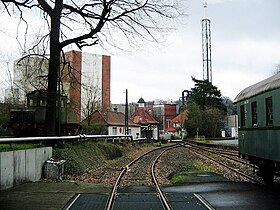Bomlitz – Walsrode railway line
| Bomlitz – Walsrode | |||||||||||||||||||||||||||||||||||||||||||||||||||||||||||||||||||||||||
|---|---|---|---|---|---|---|---|---|---|---|---|---|---|---|---|---|---|---|---|---|---|---|---|---|---|---|---|---|---|---|---|---|---|---|---|---|---|---|---|---|---|---|---|---|---|---|---|---|---|---|---|---|---|---|---|---|---|---|---|---|---|---|---|---|---|---|---|---|---|---|---|---|---|
|
Bomlitz station with Altwerk Wolff and museum vehicles
| |||||||||||||||||||||||||||||||||||||||||||||||||||||||||||||||||||||||||
| Course book section (DB) : | 163 (until 1991), ex 217g | ||||||||||||||||||||||||||||||||||||||||||||||||||||||||||||||||||||||||
| Gauge : | 1435 mm ( standard gauge ) | ||||||||||||||||||||||||||||||||||||||||||||||||||||||||||||||||||||||||
| Power system : | up to 1976: 600 V = | ||||||||||||||||||||||||||||||||||||||||||||||||||||||||||||||||||||||||
|
|||||||||||||||||||||||||||||||||||||||||||||||||||||||||||||||||||||||||
The Bomlitz – Walsrode railway is a branch line of the Heidebahn Hanover - Hamburg in Lower Saxony and is currently (2011) operated by the Osthannoverschen Eisenbahnen (OHE).
Routing
The railway line consists of two sections of different origins and routes:
- Bomlitz –Gleisdreieck– Cordingen (built and electrified 1915 as Werkbahn Wolff & Co. )
- Cordingen – Vogelpark – Walsrode (built in 1890 as the state railway line Hanover - Visselhövede )
Today, the Walsrode section of the Verden (Aller) –Walsrode Nord line is closely related to the railway :
- Walsrode – Vorwalsrode– Hollige - Altenboitzen (section of the Verden-Walsrode railway ). The entire Bomlitz – Altenboitzen line is also called the Jordan-Bomlitz Railway , as it leads from the Jordanbach valley into the Bomlitztal valley.
What is remarkable about the route of the Werkbahn section are the clear inclines that the turbulent terrain forced in the valleys of the Bomlitz and Warnau . The Kiebitzort stop and the Bomlitz train station could not be laid out horizontally.
history
Bomlitz – Cordingen section
The in-house section of the line had a first forerunner in a field railway network operated by Wolff & Co. , which existed between 1875 and 1945. The Wolff company mainly produced black powder and low-smoke powder . The standard gauge works railway from Cordingen to Bomlitz was opened on May 15, 1915 to Kiebitzort and completed in 1916. At first a steam locomotive was used, but in 1915 the railway was electrified with 600 volts DC . It was the first electrically operated railway line in what is now Lower Saxony. Three electric locomotives were available for this, four from 1943. Since the thirties, however, diesel locomotives have also been used in the growing factory traffic. A used benzene railcar was procured in 1940 for the continuous passenger traffic Bomlitz – Walsrode .
From 1938 a connection branched off via a triangle at the Benefeld stop , which reached the Honerdingen station on the Walsrode – Soltau line via the Eibia ammunition factory . Efficient one-way traffic was handled over these routes from 1939. In 1944 the Werkbahnen had a length of 31.6 kilometers.
After 1945 the factory railways were significantly reduced. Instead of explosives, mainly cellulose products were produced in the Bomlitz plant .
From 1977 the electrical operation was limited to the factory premises and completely stopped in 1979. The overhead line has been dismantled since then, only in Bomlitz station is the locomotive 1 (in service from 1916 to 1976) alongside other museum vehicles under the former contact wire .
Until May 31, 1991, the Wolff Walsrode AG works railway also carried out limited public transport, which had been extended to Walsrode from 1942. In addition to the railcars, there were also private cars. Most recently, passenger coaches rented by the Deutsche Bundesbahn were used. Since these were no longer available from 1991, passenger transport was completely switched to buses. The timetable had previously been reduced to practically all school traffic.
The goods traffic serves the companies in the industrial park Walsrode , which mainly emerged from Wolff Walsrode AG. Around 60,000 tons are currently transported by rail every year.
Cordingen – Walsrode section
The Cordingen – Walsrode section is part of the Hanover – Bremervörde railway line between Cordingen and Rotenburg .
On January 1, 1997, Wolff AG also acquired the Cordingen – Walsrode section from Deutsche Bahn. Probis, a subsidiary of Dow Wolff Cellulosics , took over the infrastructure in 2002. Since March 1, 2002, operations management has been with the Osthannoverschen Eisenbahnen (OHE).
Tourist traffic
As on other OHE routes, the Arbeitsgemeinschaft Verkehrsfreunde Lüneburg e. V. on this route and the Walsrode – Altenboitzen section of the Verden (Aller) –Walsrode Nord railway line with the Heideexpress , for which a new stop should be set up at the Walsrode World Bird Park . This new stop has not been built to date (as of September 2013).
vehicles
In 1970 a MaK G 700 C was procured and named No. 8, which took over the management of the passenger trains because of its top speed of 60 km / h. However, the locomotive did not have a train heater. In 2002 it was sold.
literature
- Helmut Roggenkamp: The electric traction in the freight traffic of the non-federally owned railways and the works railways. In: Lok Magazin , issue 117, November / December 1982, pp. 458–469.
- Gerd Wolff: German small and private railways. Volume 10: Lower Saxony 2. Between Weser and Elbe. EK-Verlag, Freiburg 2007, pp. 209-219, ISBN 978-3-88255-669-8
Web links
- heide-express.de of the Arbeitsgemeinschaft Verkehrsfreunde Lüneburg
- Photos of the factory railway 1987
- Photos from Bomlitz station
- Historical photos of the electrified factory railway
Notes and individual references
- ^ Infrastructure since January 1st, 2002 owned by Probis
- ↑ Operation from January 1, 1997 by Wolff Walsrode, infrastructure since January 1, 2002 owned by Probis
- ↑ Infrastructure owned by VWE
- ^ In front of the Bad Eilsener Kleinbahn , which went into operation electrified in 1918
- ↑ Locomotives 2 and 3 were in operation from 1915 . Source: H. u. R. Wasser, family book Schüngel , Bomlitz, 1986, p. 2468 f
- ↑ Gerd Wolff: German small and private railways. Volume 10: Lower Saxony 2. Between Weser and Elbe. EK-Verlag, Freiburg 2007, p. 217
- ↑ Link no longer works!


